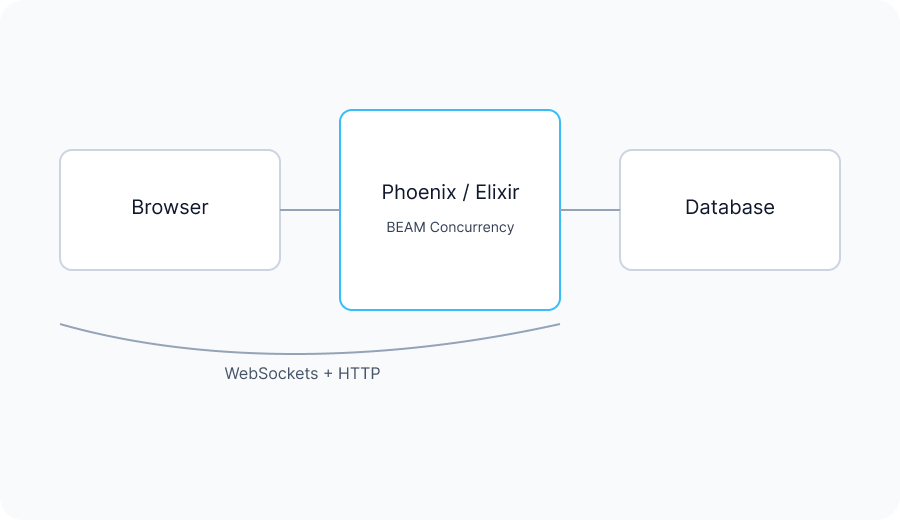The Case for Elixir: Scalable, Fault-Tolerant, and Fun (2025)

Explore the case for Elixir with a detailed breakdown of its performance, concurrency, fault-tolerance, and adoption by major companies. An essential guide for engineers, CTOs, and startups evaluating modern tech stacks.
- Name
- Nicolas
- @nicolashoban
20 days ago
Elixir is often hailed as a secret weapon for building scalable and maintainable software. Yet many teams stick to familiar stacks (JavaScript, Java, etc.) and overlook this powerful functional language. This post makes a comprehensive case for Elixir – explaining what it is, why it’s unique, and how it delivers clear benefits in real-world systems.
Our target audience includes startup founders, engineers, CTOs, and product managers, and we’ll take a factual, technically deep (yet high-level) look at Elixir’s advantages.
What Exactly Is Elixir?
Elixir is a modern functional programming language built on the decades-proven Erlang Virtual Machine (the BEAM). Created by José Valim in 2011, Elixir was designed to be friendly, concise, and efficient, while inheriting Erlang’s strengths in concurrency and fault-tolerance.
Key points
- Runs on the BEAM VM — the same telecom-grade VM Ericsson built for high-availability systems.
- Phoenix Framework — designed by experienced Rails engineers to address speed, scalability, and real-time needs.
- PETAL Stack — Phoenix, Elixir, Tailwind CSS, Alpine.js, LiveView.
Example stack diagram

Unparalleled Concurrency & Scalability
One of Elixir’s most inarguable advantages is its ability to handle massive concurrency. Thanks to the BEAM’s actor model and lightweight processes, Elixir systems can support millions of parallel operations without slowing down.
Real-world proof points
Discord
- Real-time chat infrastructure built in Elixir
- Handles 12M+ concurrent users
- 26M+ events per second
- Maintained by a team of just 5 engineers
- Routes 30,000 events/sec
- Cut infrastructure from 30+ servers to 15
- Reduced code complexity significantly
WhatsApp (Erlang)
- 2M+ concurrent connections on a single node
- BEAM’s concurrency capabilities directly inherited by Elixir
Bleacher Report
- Migrated from Rails to Elixir
- Reduced from 150 servers to 5
- Billions of pageviews + millions of push notifications daily
Square Enix
- Uses Elixir for MMO backend, chat, & authentication
- Handles millions of concurrent players
Elixir excels at handling real-time, high-intensity workloads naturally and efficiently.
Fault-Tolerance and Reliability
Elixir’s “let it crash” philosophy ensures robust fault isolation and automatic self-healing through OTP Supervisors.
Why Elixir’s reliability is unmatched
- Each process is isolated — crashes don’t cascade
- Supervisors automatically restart crashed parts
- No shared memory → fewer race conditions
- Per-process garbage collection → no global pauses
- Systems regularly achieve 99.999%–99.9999999% uptime
Real-world impact
- Financial Times praises robustness in production
- Toyota Connected relies on Elixir for safety-critical vehicle data ingestion
- Apple uses Elixir in internal data pipelines
Elixir is designed to stay online under pressure.
Developer Experience and Productivity
Elixir is consistently ranked as one of the most loved programming languages, and Phoenix as the most loved web framework.
Why engineers love it
- Clean syntax (inspired by Ruby)
- Pattern matching → clear, predictable flow
- Functional programming minimizes side effects
- Mix tool → excellent project/dependency management
- Phoenix LiveView → real-time UIs with minimal JavaScript
- Amazing documentation & community
Teams report:
- Faster feature development
- Easy onboarding
- Fewer bugs
- Smaller infrastructure footprints
Startups especially benefit, as small teams can build production-grade systems fast.
Real-World Adoption
Elixir is used across industries:
- Discord – real-time messaging backend
- Pinterest – event routing
- Bleacher Report – massive traffic + push notifications
- Toyota Connected – connected vehicle platform
- Square Enix – multiplayer game services
- PepsiCo – manufacturing systems
- Financial Times – backend services & GraphQL
- Apple – internal data processing pipelines
Adoption is growing steadily each year.
When to Consider Elixir
Elixir is an excellent fit when building:
- Real-time apps (chat, dashboards, multiplayer, notifications)
- High-concurrency systems (IoT, event pipelines)
- High-reliability systems (finance, medical, industrial)
- Event-driven architectures
- Distributed systems
- Products built by small, fast-moving teams
Less ideal when:
- Doing heavy CPU-bound computation (use NIFs/Rust)
- Building tiny CRUD apps with no growth expectations
- Hiring large teams of juniors immediately
Conclusion: A “Better Tool” for Many Jobs
Elixir offers a powerful combination of scalability, fault tolerance, and developer joy — all built on the extremely mature engineering foundation of Erlang/OTP.
Whether you’re a founder, CTO, developer, or product manager, Elixir provides:
- Lower infrastructure costs
- Higher reliability
- Faster iteration
- Happier engineering teams
If you’re building something ambitious, real-time, or expected to scale quickly, now is the perfect time to give Elixir a serious look.
More posts












